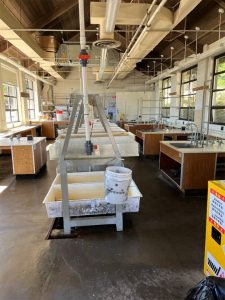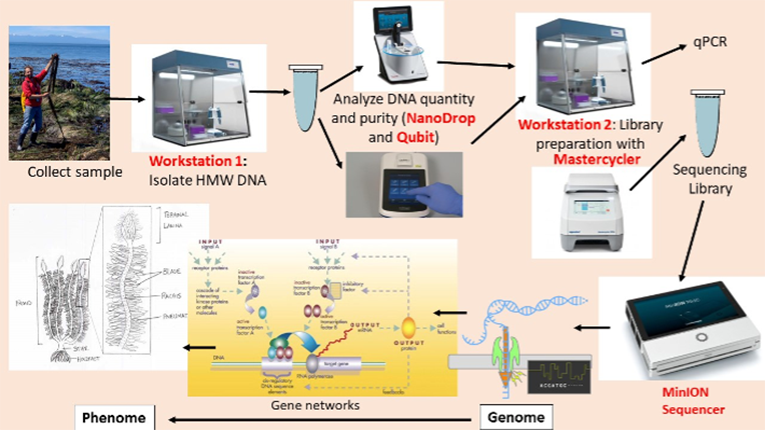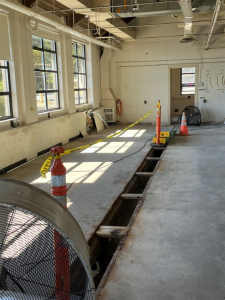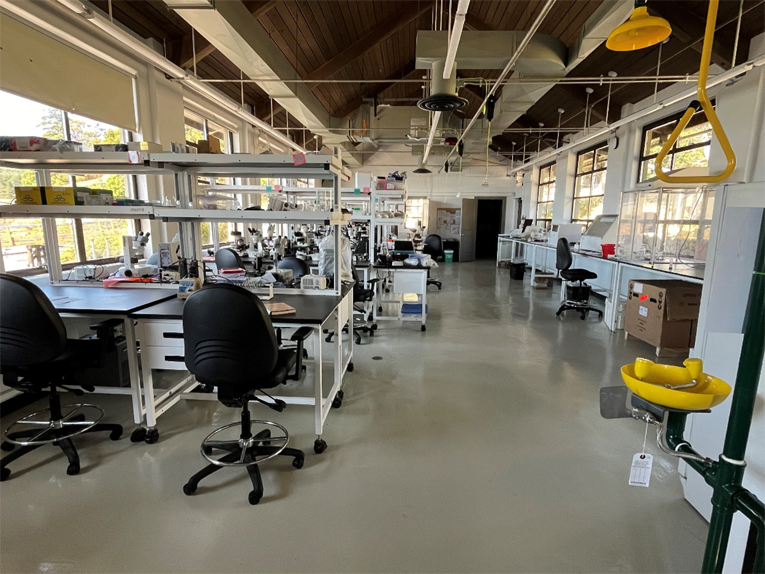From Neurons to Genes and Back Again: Lab 2 Renovation
by Director Megan Dethier

Many of FHL’s buildings, including the wet labs along the waterfront, are close to 100 years old. The labs were built in the 1920s and partially remodeled in the 1980s with new windows and wallboard – but even those ‘new’ features are now 40 years old and fading! It’s a challenge to secure funding for renovations: we have to compete with many aging structures on the Seattle campus for support from UW Facilities, and with more appealing new construction for support from donors. Enter the National Science Foundation’s Field Stations and Marine Labs program! This branch of NSF supplies funds for infrastructure if the work “expands capacity” in some way for the institution – i.e. brings in new users or enables new research – just renovating an old building and using it in the same way doesn’t qualify for funding.
So early in 2021, at the height of the pandemic, Adam Summers, Billie Swalla and I wrote a proposal to renovate Lab 2, which for decades had been “the Neuro Lab,” and transform it into a “Marine Genomics Center.” We originally proposed a “Genome to Phenome Center” with equipment to link organisms’ genes with their eventual morphology, and the proposal included a fancy new microscope. However, input from NSF on that first proposal was that the concept wasn’t focused enough. So for Round 2, we set our sights on making a high quality genomics lab with modern equipment, both new and with added equipment already in Billie’s lab. For the science side of the proposal, we collected statements from diverse researchers about how the proposed changes would facilitate research and teaching for them at FHL and attract new users. Billie corresponded extensively with colleagues about the equipment we should target (since NSF and its reviewers want to see very concrete details, including quotes from companies). A consistent goal was choosing equipment that was user-friendly and as durable as possible, since common-use equipment does lead a hard life with potentially inexperienced users. In all phases of this effort, we found that there were as many opinions about equipment and building configuration as there were potential users, so coming to decisions was often challenging – but there was also a lot of excitement about the project! Figure 2 shows the equipment needed for some types of scientific research that we envisioned being done in the new Center, and for which we were requesting funding.

In terms of the building itself, luckily the basic structure was in good shape and didn’t need work. Maintenance supervisor Doug, Operations Manager Bernadette and I did many walkabouts to come up with a plan for a large, central workspace that was clean and dry (suitable for sensitive equipment and with fewer contaminants for DNA work) but with easy access to running seawater for maintaining research organisms. We decided to confine sea tables to the corner room that had previously held a magnetic coil for neurophysiology work – a change that would require re-plumbing of the drains and filling in of the seawater trough in the main room (Figure 3). To ensure that the lab could be readily used by researchers and students with mobility challenges, we also planned for larger door frames and an automatic opener for the main exterior door. In addition, we proposed to refinish the floor, replace the non-functional heat pump, tear out all the ‘nasty’ rusty cabinetry, and buy mobile lab benches and tables so the space could be reconfigured for workshops, classes or independent researchers. Many of these changes meant that the electrical system in the building needed to be completely re-done because most of these original lab buildings have chronic issues with electrical supply caused by old wiring – and while we were doing that, putting in new lights to replace the old fluorescent fixtures made sense. Getting bids for the elements that needed outside contractors was a major challenge in the height of the pandemic!

To our delight, in the summer of 2022 NSF awarded us almost $400,000 for this project, about 2/3 for building renovation and 1/3 for new equipment. Talking to the NSF program officer, we learned that one reason we received the award (after competition with proposals from other field stations) is that we proposed to complete most of the renovation work in house, using our own wonderful maintenance crew, thus reducing the chance of huge cost overruns that have plagued other NSF-funded renovation projects.
Shortly after notification of the award (and filling out a LOT of forms for the University about the renovation plan), the crew jumped right into the project and Doug started lining up contractors for the specialty work that needed to be outsourced. It was challenging adding the rest of the renovation work onto our maintenance crew’s already full plates, but they enjoyed the satisfaction of making the building look beautiful. They also managed to recycle and refinish some counters and sinks, thus keeping costs under control. At the same time, Billie and postdoc Becca Maher, with advice from many others, started looking into the latest models of relevant equipment and pondering layout of the new spaces. There are so many details for such a lab: ice machines, autoclaves, flammables cabinets, eye washes, types of freezers, tough material for work surfaces, and even color of the floor paint! Many other staff had key input or helped with essential processes, such as Peggy ordering equipment and Morgan helping to choose sturdy chairs. As with so much of what we do at FHL, it takes a village.
Figures 1, 3 and 4 show the visuals of this transformation. Becca and Billie spent countless hours moving and setting up equipment. Becca will write a future Tide Bite article about the genomics work she is doing with the microbiome of eelgrass using many of these new tools. In addition, almost the minute the building was ready it was occupied by an Advanced Invertebrates course during Summer B 2024, with Eric Edsinger and Kyle McCulloch teaching “Functional Biodiversity” using the new genomics tools plus many other pieces of high-tech equipment to investigate development of nervous systems in marine invertebrates. Thus we are already seeing the “expanded capacity” that NSF funds enable – including research that brings us full circle to the building again being used (in part) for investigation of nervous systems, but with new modern tools!

We anticipate that the capabilities of this equipment and the space will continue to expand with future researchers, as new ways of combining techniques become standard practice. Next summer we expect that several classes (especially Invertebrates and Botany) and at least one workshop (on eDNA methods) will take advantage of these tools. This Fall we are preparing a detailed list of Marine Genomics Center equipment and circulating it around the research community, hoping to attract new users who can benefit from what our proposal summarized as “cutting edge tools right at the water’s edge.” Huge thanks to the National Science Foundation and to our dedicated staff and scientists for making this all possible!
Tide Bites is a monthly email with the latest news and stories about Friday Harbor Labs. Want more? Subscribe to Tide Bites or browse the archives.